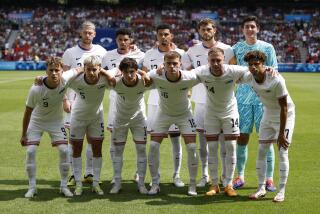Now It’s Our World
The last time the World Cup came to America, during the we’re-not-worthy, please-don’t-hurt-us summer of ‘94, the United States looked at its first-round grouping with Colombia, Romania and Switzerland and said, with full confidence, “Well, at least we’ll get three games in.”
Then the United States tied Switzerland, 1-1, in its opener and there was rejoicing in the streets. “Hey, did you hear? We scored a goal!”
Then the United States beat Colombia when a Colombian kicked the ball into his own net, amid media speculation that the Colombians were tanking the game for gun-toting gambling interests in Bogota. The next morning, the newspapers called it The Greatest Day In The History of American Soccer.
Then the United States lost to Romania, 1-0, on a soft goal that skittered inside the near post. The next day, the headlines rhapsodized: “USA REACHES SECOND ROUND!”
Then the United States lost, 1-0, to Brazil on the Fourth of July while playing with a one-man advantage for the second half. The next day, out-of-the-tournament Americans proudly clapped each other on the back. “Hey, we lost to the best team in the world by only one goal!”
That was what we called a successful World Cup in 1994. Four games played, one win, two goals scored by American players. But we didn’t get embarrassed, it could have been worse, we didn’t lose to Iran--yes, Mundial ’94 qualified as an unqualified great leap forward for American soccer.
But that was then, and those were the men.
This World Cup will be played by women.
How big a difference is that?
What is the difference between finishing last and finishing first?
To put it another way, world:
This is our turf, our house, our sport, our World Cup to lose. No more of this three-losses-and-out, 32nd out of 32 teams, finishing behind everyone from Jamaica to Morocco to South Korea to South Africa and having television commentators around the globe laughing at our very name.
For the next three weeks, the United States is the favorite to win the World Cup, the team to beat, the system that has the rest of the world scrambling to play catch-up.
For the next month, soccer is America’s Game.
For as long as the Americans playing the soccer are named Michelle and Mia, Kristine and Carla, Brandi and Tiffeny.
At first glance, there are several obvious differences between the men’s and women’s World Cups. For instance, there is a greater abundance of ponytails in the Women’s World Cup--give or take the Italian national team. There are also more goals, fewer red cards, fewer writhing swan dives whenever a defender brushes up against the shoelaces of the player with the ball and, generally, friendlier dispositions in the postmatch interview area.
Beyond that, the Women’s World Cup exists as almost a parallel universe of international soccer, with standings and traditional reputations bounced on their heads. Here, France and Argentina are non-qualifiers, Italy and Germany are also-rans, Brazil is a longshot--and the United States is the reigning powerhouse.
There are many cultural and sociological reasons for this, but to keep it inside the nutshell: International women’s soccer is a relatively new phenomenon--the first women’s World Championship was held in 1991, the first women’s Olympic soccer tournament in 1996--and the United States, being less chauvinistic about women playing soccer than the Old World powers, got a flying head start. Thus, of the first three major trophies to have been awarded in women’s international soccer, two have gone to the United States--the 1991 World Championship and the 1996 Olympic gold medal.
But in 1991, most Americans hadn’t heard of the women’s World Cup, never mind the news that we had won it. And in 1996, an NBC blinded by replays of Kerri Strug grimacing on one leg neglected to televise all but a scant few minutes of the Olympic women’s soccer final, blacking out most of the United States’ thrilling 2-1 victory over China across the country.
What this means in 1999 is a new viewing experience for the average American sports fan.
The World Cup is here, and it’s on television, and it says here we’re supposed to win it. You know, this might be worth a look-see.
“Americans love winning teams,” says Julie Foudy, a midfielder on the U.S. women’s national team and a color commentator for ESPN during the men’s World Cup in 1998. “Americans want to see American teams be successful. People are drawn to successful teams.
“In 1994, the World Cup was a novelty. People were interested, not by the expectation of seeing the U.S. win, but because this great international event was coming to the United States. There was more of a curiosity factor in ‘94--’What’s behind this? I want to be involved.’
“With this World Cup, it’s almost expected that we will win it. It’s like, ‘You won the Olympics, you’re playing here in the USA, you should win.’ We’re easy favorites. That’s the selling point this time around.”
That places a burden of pressure on the American women that has never been shouldered by the American men in any World Cup. Good thing, too. Look how well the American men handled the sure-thing expectations of their can’t-lose match against Iran last summer.
The American women, however, have been there before. They won in 1991, they won in 1996 and, in the words of their coach, Tony DiCicco, “no one’s expectations are higher than our own” in 1999.
“Our only goal,” DiCicco says, “is to have that gold medal hanging around our necks.”
For American soccer fans used to seeing only Brazilians, Germans and Frenchmen adorned with such ornaments, that prospect looms as quite a sight. Promise them that and who knows what inroads the sport might make in this previously hostile-to-indifferent soccer backwater.
As DiCicco acknowledges with a nod and a wry smile, “I know our best way to sell tickets is to win.”






